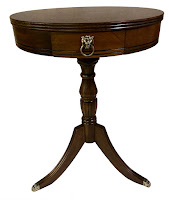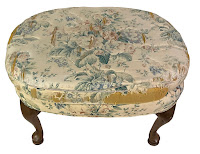 |
| Rocking Chair After |
 |
| Rocking Chair Before |
Some projects go very smoothly. This rocking chair was not one of them since it was in dire straits. The arms were shredded and there was a large hole on the right top of the seat. The rocking chair was over 45 years old and had seen a lot of use, possibly damaged from a dog as well. Indeed, it was time for an upholstery revival on this old rocking chair.
The seat cushion was badly worn and the foam was so flat it wasn't able to support you properly. Originally a 3" cushion, the old cushion had been reduced to about 1-1/2 to 2". I had a brand new T-cushion made then designed a brand new cushion cover with the new material. It turned out perfectly. T-cushions can be tricky especially with top and bottom welt cording, which I used for this cushion. The curve-around zipper makes it easy to slip over the foam. Once that was complete, I tackled the back portion.
Unlike other chairs I've done, this one had a separate cushion on the front half but it was stitched to the inner back panel with the back section wrapped around the top and sides of the chair and attached to the interior of the back and sides. This made the removal process extremely difficult and as I soon found out as I progressed with the removal of the old material, it was apparent that this factory style method of construction would be impossible to duplicate.
This turned out to be a typical catch 22 situation; during fabric stripping, I had to remove each section to learn how it was assembled, but when the time came to stitch it back together, I couldn't replicate the exact method as it was put together, since it had been taken apart to use for templates. Even with detailed markings, numbering and many photos, I found it simply wasn't possible to recreate the original construction, so I chose to build this rocking chair by building loose cushions for both the seat as well as the back. My preferred method had a couple of great advantages. It made the project's assembly much more efficient, because with loose cushions as opposed to attached, they can be easily dry-cleaned, plus the cushions can be reversed for even wear. Finally, the overstuffed cushions were really comfortable. Bonus!
I padded the backing and covered it with fabric front and back after replacing the original, insufficient webbing. They had only three strips and I replaced those with four. Much stronger and more support. The under spring assembly was also covered with thin foam and finished off with the floral material. Edge rolls were used for comfortable seating. Once the structure was all done and the cushions in place, it fit together perfectly.
The customer selected a lovely floral pattern which was a far cry from the original outdated and worn material which had seen better days. The bones of the chair were very good, strong and stable, so with the newly upholstered material, this chair should last for many years to come.
































